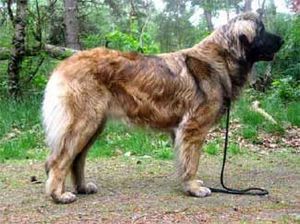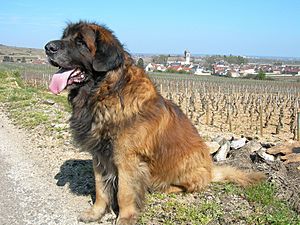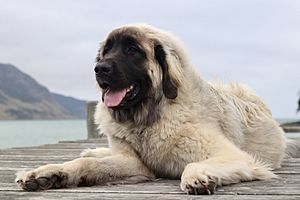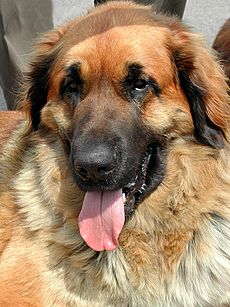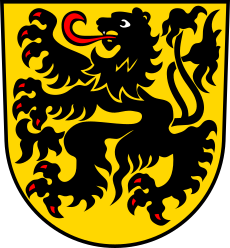Leonberger facts for kids
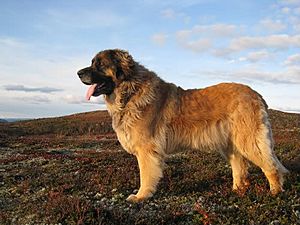 |
|||||||||||||||||||
| Common nicknames | Leo | ||||||||||||||||||
|---|---|---|---|---|---|---|---|---|---|---|---|---|---|---|---|---|---|---|---|
| Origin | Germany | ||||||||||||||||||
|
|||||||||||||||||||
|
|||||||||||||||||||
| Domestic dog (Canis lupus familiaris) | |||||||||||||||||||
The Leonberger is a large dog breed that gets its name from the city of Leonberg in Germany. These dogs are known for being strong, friendly, and very smart. They are often called "Leos" for short.
Description
What do Leonbergers look like?
Leonbergers are big, strong, and graceful dogs. They have a thick double coat of fur. Their heads often have a striking black mask around their eyes and muzzle. This gives them a look that shows they are intelligent, proud, and kind.
These dogs were first bred to be helpful family pets and working dogs. They are especially good at search and rescue, especially in water. Even though they are large, Leonbergers are surprisingly quick and move well.
Male and female Leonbergers look different from each other. This is called sexual dimorphism. Males look very strong and masculine, while females look more elegant and feminine. You can easily tell them apart.
How big are Leonbergers?
Leonbergers are very large dogs.
- Height:
- Male dogs are usually between 71 and 80 centimeters (28 to 31 inches) tall. The average male is about 75 centimeters (30 inches).
- Female dogs are usually between 65 and 75 centimeters (26 to 30 inches) tall. The average female is about 70 centimeters (28 inches).
- Weight:
- Male dogs often weigh between 54 and 77 kilograms (120 to 170 pounds). The average male is about 66 kilograms (145 pounds).
- Female dogs often weigh between 45 and 61 kilograms (100 to 135 pounds). The average female is about 52 kilograms (115 pounds).
Because they are built for hard work, Leonbergers have a lot of muscle and strong bones. Their chests are wide and deep, which helps them with their jobs.
Their Head and Face
A Leonberger's head is in good proportion to its body size. It is deeper than it is wide. The length of their muzzle is about the same as the length of their skull.
Their eyes are medium-sized and almond-shaped. They are usually dark brown and set slightly slanted in their skull. Their eyelids fit closely.
Their ears are fleshy and medium-sized. They hang close to the skull, with the tips reaching about the level of the corners of their mouth.
Leonbergers usually have a strong "scissor bite." This means their upper teeth slightly overlap their lower teeth.
Their Fur Coat
The Leonberger's fur coat is very important for the breed. It is a double coat that is water-resistant. This helps them stay dry, especially when working in water.
The outer coat is long, thick, and mostly straight. It lies flat against their body. Male Leonbergers have a noticeable "mane" of fur around their neck and chest. Their tail is also very furry from top to bottom. Underneath the outer coat, they have a soft and dense undercoat, which helps keep them warm.
Leonbergers do not need much trimming. Usually, only their feet are tidied up.
What Colors are They?
Leonbergers can come in several colors. These include lion-yellow, red, reddish-brown, and sand. They can also be a mix of these colors.
Their nose, paw pads, and lips should always be black. Some colors are not allowed for the breed, such as brown with a brown nose, black and tan, black, white, or silver. Their eyes should always have some brown color. A small white patch on their chest or toes is allowed.
What is their Temperament Like?
The most important thing about a Leonberger is its personality. They are first and foremost a family dog.
When they are well-trained and socialized from a young age, Leonbergers are confident and calm. They are usually not bothered by loud noises. They are gentle with family members, especially children. They are also friendly towards strangers and can protect their family or home if needed.
Leonbergers are strong, loyal, smart, playful, and kind. This means they can go almost anywhere without trouble. They also adapt well to new situations, even when other dogs are around. Because they are a giant breed, it is very important to train and socialize them early.
Health of Leonbergers
Common Health Issues
Leonbergers are generally strong and healthy dogs. However, like all breeds, they can have some health problems.
One common issue in large breeds is hip dysplasia. This is a problem with the hip joints. Many breeders work hard to check their Leonbergers for this condition using X-rays. They try not to breed dogs with hip dysplasia to reduce the risk for puppies. This has helped lower the number of Leonbergers with hip dysplasia over the years.
While not very common, Leonbergers can also get other health issues. These might include heart problems, a nerve condition called Leonberger polyneuropathy, and certain types of cancer like osteosarcoma and hemangiosarcoma. They can also have allergies, eye problems like cataracts, and thyroid issues.
Some people think Leonbergers are more sensitive to anesthesia, but this is not true. Like other large dogs, they just need a different dose of medicine per pound of body weight compared to smaller dogs.
There are groups like the Leonberger Health Foundation that support research to find genetic markers for serious diseases in the breed. They focus on cancers and polyneuropathy.
How Long Do They Live?
Leonbergers usually live for about 7 years. This is a bit less than the average purebred dog, but it is typical for very large breeds. About 20% of Leonbergers live to be 10 years old or more. The oldest Leonbergers have lived to about 13 years old.
Serious diseases, especially certain types of cancer, are common causes of death in the breed. Another serious condition that affects many large dogs is bloat. This is when the stomach twists and can be very dangerous. To help prevent bloat, adult Leonbergers should be fed two smaller meals a day instead of one large meal.
Compared to some other dog breeds, Leonbergers are considered to have relatively few health problems overall.
History of the Leonberger
How the Breed Started
In the 1830s, a man named Heinrich Essig lived in the town of Leonberg, Germany. He was a dog breeder and also the mayor of the town. Essig claimed he created the Leonberger breed.
He said he crossed a female Landseer Newfoundland dog with a male Saint Bernard from the Great St Bernard Hospice and Monastery. Later, he added a Pyrenean Mountain Dog to the mix. This resulted in very large dogs with long, white coats, which were popular at the time. These dogs also had a friendly personality.
The first dogs officially called Leonbergers were born in 1846. They had many good qualities from the breeds they came from. The story goes that Essig wanted to create a dog that looked like the lion on Leonberg's town crest and coat of arms.
The Leonberger dog became popular with many royal families in Europe. Famous people like Empress Elisabeth of Austria and Otto von Bismarck owned them. However, some people argued that Essig's story about how he created the breed was not entirely true. Records from as early as 1585 might show that dogs similar to Leonbergers existed before Essig. But it is clear that Essig was the first to name and register the breed.
Leonbergers in History
The Leonberger we see today, with darker coats and black masks, was developed later in the 20th century. This happened because the number of Leonbergers dropped a lot during World War I and World War II. Only a few Leonbergers survived World War I. Then, almost all were lost again during World War II. During these wars, Leonbergers were used to pull ammunition carts, which was a dangerous job.
Karl Stadelmann and Otto Josenhans are known for saving the breed from almost disappearing. Today, all Leonbergers can trace their family tree back to the eight dogs that survived World War II.
Historically, Leonbergers were used as farm dogs. They were excellent at being watchdogs and pulling carts. You could often see them pulling carts in villages in Germany. Around the early 1900s, the Canadian government even imported Leonbergers to use as water rescue dogs. They still do this job today, along with breeds like the Newfoundland and Labrador Retriever. They are also used as guard dogs for farm animals.
The Leonberger breed was officially recognized by the American Kennel Club (AKC) on January 1, 2010. It was the 167th breed to be recognized by the AKC.
See also
 In Spanish: Leonberger para niños
In Spanish: Leonberger para niños


